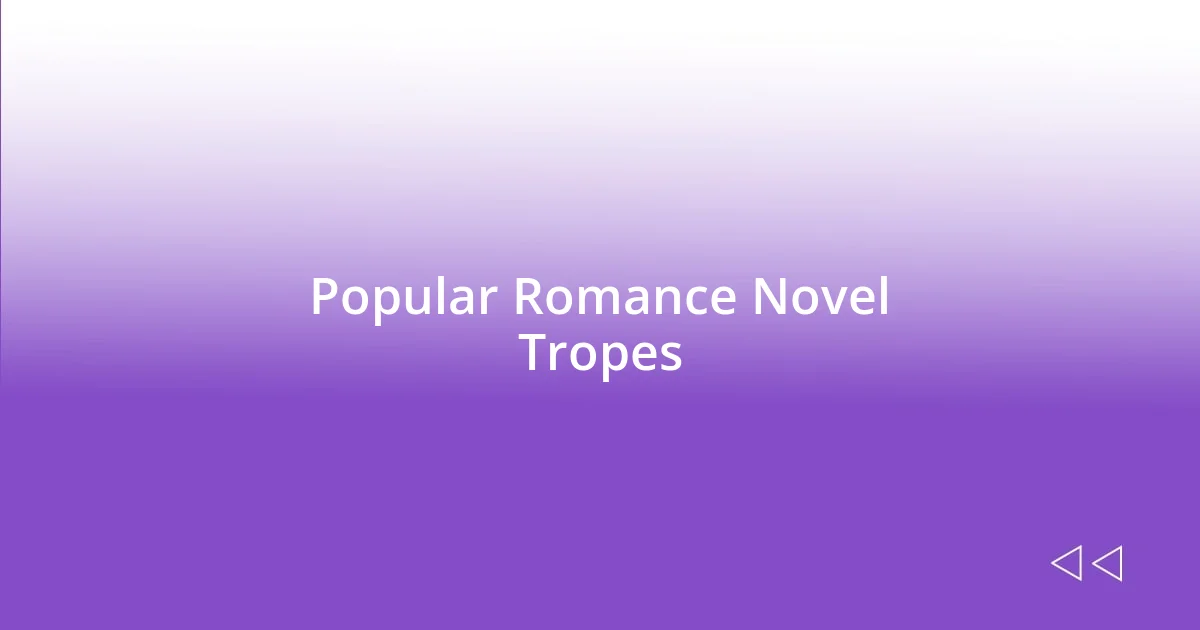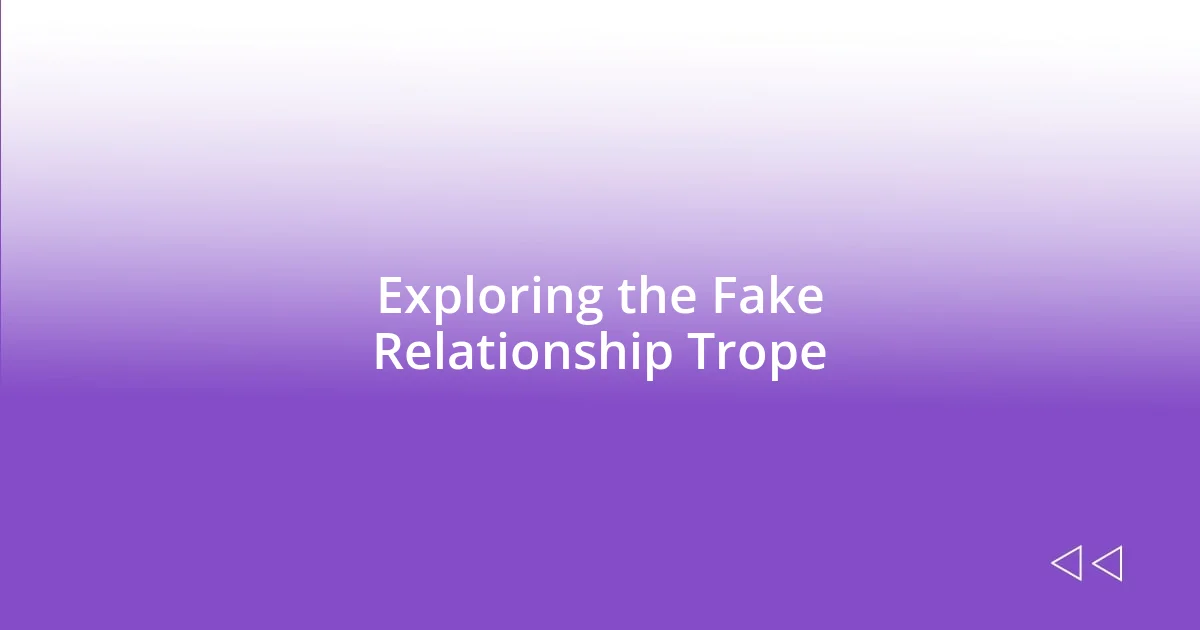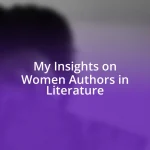Key takeaways:
- Romance novel tropes, such as “second chance,” “friends to lovers,” and “fake relationship,” shape readers’ expectations and evoke relatable emotions.
- The slow burn trope allows for gradual emotional engagement, mirroring real-life relationships and building anticipation for character connections.
- Recommended reads like “The Hating Game,” “It Ends With Us,” and “The Unhoneymooners” exemplify popular tropes and explore deeper emotional themes in romantic storytelling.

Understanding Romance Novel Tropes
Romance novel tropes are the familiar themes and scenarios that recur across the genre, shaping readers’ expectations and experiences. From “enemies to lovers” to “forbidden love,” these motifs create a sense of familiarity while offering fresh spins that can surprise even the most seasoned reader. Have you ever found yourself curling up with a book only to realize that you’ve stumbled upon one of your all-time favorite scenarios? That feeling of recognition can be both thrilling and comforting.
As I reflect on my journey with romance novels, I find myself often drawn to the “second chance” trope. There’s something deeply relatable about love rekindling despite past mistakes. It’s like seeing an old friend after years apart; that rush of nostalgia mixed with the excitement of new possibilities often fills my heart with hope. How can you not root for characters who overcome their own histories to embrace love again?
Understanding these tropes not only enhances our reading experience but also invites us to explore the underlying emotions that they evoke. Whether it’s the thrill of the chase or the security of a committed partnership, each trope resonates on a personal level. I love how these narrative devices can mirror real-life emotions and situations, sometimes making us reflect on our own romantic journeys. Isn’t it amazing how a simple plot device can provoke such profound feelings?

Popular Romance Novel Tropes
When I think about popular romance novel tropes, “friends to lovers” immediately comes to mind. This dynamic feels so genuine, as it often showcases the evolution of relationships built on trust and shared experiences. I recall reading a novel where two childhood friends slowly realized their feelings for each other, and it was heartwarming to see how their bond evolved. Isn’t it fascinating how a friendship can blossom into something deeper?
Another trope that captivates my attention is the “fake relationship.” I mean, who doesn’t enjoy a bit of pretend? Watching characters navigate their staged romance, only to discover real emotions along the way, feels like a delightful rollercoaster ride. I once devoured a book where a couple pretended to be engaged for family reasons, and I couldn’t help but giggle at the tension and misunderstandings that made their journey all the more irresistible. It made me ponder: isn’t it amusing how life can imitate art in the most unexpected ways?
Lastly, the “opposites attract” trope is one that resonates powerfully within me. The clash of personalities often leads to humorous situations that spark an undeniable chemistry. I remember a novel where a stoic introvert fell for an adventurous extrovert, and their contrasting traits made the narrative so exciting. Each argument and shared moment not only tugged at my heartstrings but also highlighted the beauty in differences. Don’t you think it’s intriguing to see how love can thrive even when characters are polar opposites?
| Trope | Description |
|---|---|
| Friends to Lovers | A relationship that evolves from friendship into romance. |
| Fake Relationship | A couple pretends to be in a relationship, only to develop genuine feelings. |
| Opposites Attract | Characters with contrasting personalities are drawn to each other. |

The Importance of Slow Burn
The slow burn trope holds a special place in my heart. There’s something intoxicating about watching two characters navigate their feelings over time, gradually building tension and intimacy. I remember reading a book where the protagonists spent most of their time resisting their attraction, and each brush of their hands felt electric. That careful pacing allowed me to savor every moment, making their eventual confession all the more satisfying. It’s the anticipation that hooks me.
- It deepens emotional engagement, allowing readers to explore complex feelings.
- The gradual buildup often mirrors real-life relationships, making it relatable.
- Small moments of connection can feel monumental when developed over time.
- It creates suspense, keeping readers hooked as they wonder when the characters will finally act on their feelings.
- This method allows for rich character development, as we get to know their inner struggles and desires.
I can’t help but recall how much I enjoyed that tension in a novel where two coworkers slowly fell for each other amid office shenanigans. The little moments—a stolen glance, an unexpected laugh—made the eventual kiss feel like a long-awaited reward. I find that slow burns often carry an emotional weight that rushes lack, making the journey as captivating as the destination.

Exploring the Fake Relationship Trope
When it comes to the fake relationship trope, I find it utterly fascinating how the lines between act and authenticity can blur. I remember diving into a story where two rivals pretended to date to win favor from their mutual friends, only to stumble into unexpected chemistry. It’s like watching a carefully choreographed dance where the characters know their roles but slowly start feeling the music, don’t you think?
What intrigues me the most is the element of forced proximity that this trope brings. It often leads to all those delightful moments of tension that keep you turning the pages. I once read a novel featuring two colleagues who had to fake a relationship during a work trip, and I was glued to the twists and turns they faced—each awkward exchange and lingering gaze felt electric. Those moments can spark genuine emotions, unraveling the characters in ways they never anticipated.
Ultimately, this trope highlights how easily we can misread emotions and situations. For instance, when the characters start public displays of affection, it initially feels superficial, but soon it blossoms into something sincere. I can’t help but ponder: how often do we put up facades that hide our true desires? This layer of self-deception, paired with the inevitable discovery of real feelings, makes the fake relationship trope a thrilling ride.

Recommendations for Trope-Based Reads
For readers seeking a delightful escape into the world of enemies-to-lovers, I highly recommend picking up “The Hating Game” by Sally Thorne. I remember grinning through the banter and tension between the leads as they gradually realize that their loathing is just a thin veil for something deeper. Have you ever found yourself clashing heads with someone, only to discover an undeniable spark? The way this novel captures that transformation is nothing short of charming and relatable.
Another great pick, if you enjoy the second-chance romance trope, is “It Ends With Us” by Colleen Hoover. This book struck a chord with me because it explores the complexities of past relationships and the courage it takes to reconnect. It’s fascinating how we tend to dream of past loves, yet this story challenges that notion—showing that sometimes the people we thought we were ready to forget can have the biggest impact on our future. Reflecting on my own experiences, I can’t help but wonder how many life lessons lie in the ashes of a relationship.
If you’re intrigued by the friends-to-lovers trope, I can’t recommend “The Unhoneymooners” by Christina Lauren enough. There’s just something heartwarming about how friendships can bloom into love under unexpected circumstances. I once had a close friend whom I never thought twice about until a moment of vulnerability changed everything between us. This novel illustrates that beautifully, showcasing how the deepest connections can sometimes sprout from the most ordinary situations. It always leaves me pondering: how many relationships in our lives have the potential for something more if only we took the leap to explore them?














